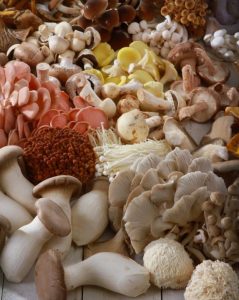A long time ago, I was a brand-new member of a local CSA farm.
I still remember the mystery of picking up our brown paper bag of vegetables every week—our name written in Sharpie on the outside and a printed list of everything inside stapled to the top.
Then came the matching game: Could I figure out which unfamiliar vegetable was which?
At the time, we lived in University City, St. Louis, with two young kids and a dog. We had dreams of growing our own food but…
St. Louis soil has terrible soil.
The hard clay barely even grew grass. Raised beds weren’t in the budget, so we had to find another way.
We first heard about CSA from our “how to live a simple life” friends in New Hampshire. Ken and Bresca were the real deal—living in a yurt, growing their own food, and selling to a local CSA. Their way of life fascinated us.
That summer, we signed up to join a CSA farm for the first time. Every Wednesday evening, we’d drive to a suburban home, walk up to the enclosed porch, and find our weekly bag of vegetables.
That’s when I met arugula and Swiss chard for the first time. And fennel—what was I supposed to do with fennel? But I dug up recipes, determined to figure it out. Some of them stuck, and to this day, I still make Portuguese Green Soup and goat cheese penne pasta with arugula.
Reuben and I both grew up in gardening families. Fresh green beans, tomatoes, and zucchini were just part of life.
We wanted the same for our kids.
But after our failed backyard gardening attempt in Illinois, we learned that some places just aren’t worth trying to grow—like under a walnut tree.
And we also learned something else: I’m not a good gardener, but Reuben is. I let houseplants die.
That first CSA experience gave us what we couldn’t grow ourselves: real food, fresh from the farm.
And it introduced us to vegetables we never would have picked up at the store.
Now, I get to do the same for you—helping you bring home the best local, organic food so your family can eat well, stay healthy, and maybe even discover a new favorite vegetable.
We’ve learned along the way that local organic food isn’t just better—it’s the best way to get healthy and stay healthy.
But finding the right CSA to join can feel overwhelming, especially if you’re new to it.
That’s why I put together this video—to help you understand what to look for and what you should know before you join a CSA farm that truly fits your needs.
Watch now and take the next step toward bringing fresh, local food to your table!
When you join our Market Box CSA at Willow Haven Farm, you’ll always know what to do with your food and have meal ideas to plan what you choose for your delivery. Blog posts like this posted every week.
So take a look at what’s in season and how to use it!
MEAL SUGGESTIONS FOR LOCAL ORGANIC FOOD THIS WEEK:
Pro tip: Always check your recipes to see what you have and what you need to purchase. Takes a few extra minutes in planning, but it beats finding out at the last minute that you’re missing ingredients!
Roasted Merguez Sausage with Apples and Onions has a beautiful balance of sweet and spicy. This sheet pan meal is on the table in under an hour.
Using sausage to make burgers is a great shortcut – the meat is already seasoned. Try these Italian Sausage Burgers with Garlicky Spinach for your next burger night. Keep the spinach topping or swap in Swiss chard from your market box, and you’ll also get a serving of important leafy greens.
Try this Sausage and Sauerkraut Skillet recipe with your pastured WHF sausage, red potatoes, apples, sauerkraut, and onion. One pan, a little bit of chopping, and 30 minutes is all you need. Serve with a salad or sauteed greens.
Pick up some individual sockeye portions (or a filet) from Wild for Salmon and try these meal ideas:
- Garlic Butter Baked Salmon – Roast with lemon, garlic, and butter at 400°F (200°C) for 12–15 minutes. Serve with roasted veggies or quinoa.
- Miso-Glazed Salmon – Brush with a miso, soy sauce, and honey glaze, then broil for a caramelized finish. Great with bok choy or rice.
If you prefer smoked salmon, try these:
- Classic Bagel & Lox – Layer on a toasted bagel with cream cheese, capers, red onion, and fresh dill.
- Smoked Salmon Scramble – Add to scrambled eggs with chives and goat cheese for a protein-packed breakfast.
Remember the Mock Apple Cobbler recipe we shared in the summer? Here’s a similar recipe for your winter vegetables – Cherry and Winter Root Cobbler. This is easy to customize – swap in your favorite fruit and experiment with different root veggies for endless possibilities.
DAIRY:
Add some chèvre to your market box to serve with smoked salmon. Choose from plain, everything bagel, garlic and basil, or onion and chive.
Remember to add butter to your list for the garlic butter salmon recipe or cherry and winter root cobbler above.
Caputo Brothers’ Italian cheeses would be delicious on sausage burgers.
MEAT and SEAFOOD:
Salmon is packed with high-quality protein, heart-healthy omega-3 fatty acids, and essential vitamins like B12 and D, which support brain function, muscle health, and immune strength. It’s also rich in antioxidants like astaxanthin, which helps reduce inflammation and promote skin health. Choose from salmon burgers, sockeye portions or filet, and three varieties of smoked salmon.
Try one of the salmon recipes above or add salmon to your favorite salad or grain bowl for a nutrient-packed flavor boost!
PANTRY RECOMMENDATIONS:
Miso adds deep umami flavor to a variety of dishes beyond Asian cuisine. Try mixing it into salad dressings, marinades for roasted vegetables or meats, or blending it into butter for a rich topping on grilled steak or corn on the cob. It also works well in creamy soups, mashed potatoes, or even caramel and chocolate-based desserts for a unique savory-sweet balance. Choose from traditional red or white chickpea miso. (Or pick up both to have on hand!)
Try a new grain this week! Whole grains are an excellent source of fiber and contain essential nutrients including B vitamins, iron, magnesium, and selenium which support overall health and well-being. They help reduce inflammation and improve gut health.
- Farro – Toss into grain bowls, use in risottos (farrotto), or add to soups for a hearty texture.
- Wheat Berries – Make a chewy salad with roasted veggies and feta, or use in breakfast porridge with nuts and honey.
- Quinoa – Add to salads, stuff into peppers, or mix into pancakes for extra protein and texture.
- Groats – Use in hearty breakfast porridge, add to soups, or make a nutty salad base or veggie burgers.
FRUIT:
Storage for all apple varieties:
Keep unwashed apples in a plastic bag in the refrigerator’s crisper drawer, where they can stay fresh for up to two weeks.
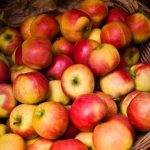 Apple, Crimson Crisp – This variety is known for its deep red skin, crisp texture, and balanced sweet-tart flavor. Crimson Crisp apples are an excellent source of dietary fiber and vitamin C. They also contain antioxidants that contribute to overall health. These medium-sized apples are perfect for fresh snacking, adding to salads, or using in baking due to their firm texture. Their balanced flavor makes them ideal for making applesauce, cider, or pies. Pair slices with cheese or nut butter for a delicious snack.
Apple, Crimson Crisp – This variety is known for its deep red skin, crisp texture, and balanced sweet-tart flavor. Crimson Crisp apples are an excellent source of dietary fiber and vitamin C. They also contain antioxidants that contribute to overall health. These medium-sized apples are perfect for fresh snacking, adding to salads, or using in baking due to their firm texture. Their balanced flavor makes them ideal for making applesauce, cider, or pies. Pair slices with cheese or nut butter for a delicious snack.
 Apple, Fuji – Fuji apples are sweet, crisp, and juicy, with a dense texture, making them a popular snacking apple. They are rich in dietary fiber, vitamin C, and antioxidants, which support digestion, immune health, and skin vitality. Fuji apples can be eaten fresh, added to salads, baked into desserts, or cooked into sauces.
Apple, Fuji – Fuji apples are sweet, crisp, and juicy, with a dense texture, making them a popular snacking apple. They are rich in dietary fiber, vitamin C, and antioxidants, which support digestion, immune health, and skin vitality. Fuji apples can be eaten fresh, added to salads, baked into desserts, or cooked into sauces.
 Apples, Golden Delicious – Golden Delicious apples are a versatile variety with a sweet, mellow flavor and a crisp yet tender texture. They are high in fiber, vitamin C, and antioxidants, which support digestion, immune health, and skin health. These apples retain their shape and flavor, making them excellent for eating fresh, baking pies, making sauces, or adding to salads.
Apples, Golden Delicious – Golden Delicious apples are a versatile variety with a sweet, mellow flavor and a crisp yet tender texture. They are high in fiber, vitamin C, and antioxidants, which support digestion, immune health, and skin health. These apples retain their shape and flavor, making them excellent for eating fresh, baking pies, making sauces, or adding to salads.
 Grapefruit – Grapefruit is a citrus fruit known for its juicy, tangy-sweet flavor with a slight bitterness. It is rich in vitamin C, fiber, and antioxidants like lycopene, promoting immune health, heart health, and skin health. Grapefruit can be eaten fresh, added to salads, or juiced for a refreshing drink. Store whole grapefruit at room temperature for up to a week or in the refrigerator for up to three weeks.
Grapefruit – Grapefruit is a citrus fruit known for its juicy, tangy-sweet flavor with a slight bitterness. It is rich in vitamin C, fiber, and antioxidants like lycopene, promoting immune health, heart health, and skin health. Grapefruit can be eaten fresh, added to salads, or juiced for a refreshing drink. Store whole grapefruit at room temperature for up to a week or in the refrigerator for up to three weeks.

Lemon – Lemons are tangy citrus fruits packed with vitamin C, antioxidants, and citric acid, which aid digestion, boost immunity, and enhance skin health. They are commonly used to add flavor to beverages, marinades, dressings, and desserts or as a natural cleaning agent. Store lemons at room temperature if using them soon or refrigerate them in a perforated bag to extend their shelf life up to 3-4 weeks.
 Orange, Mandarin – These small, sweet citrus fruits have a thin, easy-to-peel skin. They are high in vitamin C, fiber, and flavonoids, supporting immune function, digestion, and heart health. Mandarins are perfect for snacking, adding to desserts, or tossing into salads. Store them at room temperature for a few days or refrigerate to extend freshness for up to two weeks.
Orange, Mandarin – These small, sweet citrus fruits have a thin, easy-to-peel skin. They are high in vitamin C, fiber, and flavonoids, supporting immune function, digestion, and heart health. Mandarins are perfect for snacking, adding to desserts, or tossing into salads. Store them at room temperature for a few days or refrigerate to extend freshness for up to two weeks.
 Orange, Navel – Navel oranges are sweet, seedless, and easy to peel, making them an excellent snack or addition to salads and desserts. They are high in vitamin C, fiber, and antioxidants, which promote immune health and support heart health. Store navel oranges at room temperature for up to a week or refrigerate them in a mesh bag for up to three weeks to maintain freshness. Wash before peeling or slicing.
Orange, Navel – Navel oranges are sweet, seedless, and easy to peel, making them an excellent snack or addition to salads and desserts. They are high in vitamin C, fiber, and antioxidants, which promote immune health and support heart health. Store navel oranges at room temperature for up to a week or refrigerate them in a mesh bag for up to three weeks to maintain freshness. Wash before peeling or slicing.
 Mango – This tropical fruit is known for its juicy, sweet, and slightly tangy flavor. It’s rich in vitamin C, vitamin A, and fiber, supporting immune health, vision, and digestion. Mangoes can be eaten fresh, blended into smoothies, added to salsas, or used in desserts. Store unripe mangoes at room temperature until they soften, then refrigerate ripe ones for up to a week.
Mango – This tropical fruit is known for its juicy, sweet, and slightly tangy flavor. It’s rich in vitamin C, vitamin A, and fiber, supporting immune health, vision, and digestion. Mangoes can be eaten fresh, blended into smoothies, added to salsas, or used in desserts. Store unripe mangoes at room temperature until they soften, then refrigerate ripe ones for up to a week.
Fun Fact: Mangoes belong to the same plant family as cashews and pistachios!
 Pear, Bosc – Bosc pears are a brown-skinned pear variety known for their dense, crisp texture and sweet, slightly spicy flavor. They are high in dietary fiber, vitamin C, and potassium, supporting digestion, immune health, and heart function. Bosc pears are excellent for eating fresh, baking, poaching, or adding to salads, as they hold their shape well when cooked. Store unripe Bosc pears at room temperature until they soften slightly, then refrigerate to maintain freshness for up to a week.
Pear, Bosc – Bosc pears are a brown-skinned pear variety known for their dense, crisp texture and sweet, slightly spicy flavor. They are high in dietary fiber, vitamin C, and potassium, supporting digestion, immune health, and heart function. Bosc pears are excellent for eating fresh, baking, poaching, or adding to salads, as they hold their shape well when cooked. Store unripe Bosc pears at room temperature until they soften slightly, then refrigerate to maintain freshness for up to a week.
Organic Veggies We Harvested This Week:
To help you use everything in your box this week, use this Meal Planning Guide to keep track of what’s in the fridge, what needs to be used first, and what you have planned or prepped for each day.
Every member’s customized Market Box is unique so we hope you will take advantage of more varieties of vegetables as you get comfortable with all the great organic produce we are offering.
Tessa’s Tips
What to use first: pears, greens, mushrooms
Longest Storage: apples, beets, carrots, garlic, Jerusalem artichokes, potatoes
Pro-tip: Look at the items in your market box right away and decide how you will use them in your meal planning for the week. Freeze any veggies you know you won’t be able to eat in the week.
 Beet, Golden – Golden beets are a vibrant yellow-orange variety of beetroot with a mild, sweet flavor that is less earthy than red beets. They are packed with fiber, potassium, manganese, vitamin C, and antioxidants, contributing to heart health, digestion, and immune support. Their bright color makes them a visually appealing and nutritious addition to meals, and they don’t stain like their red counterparts. They can be roasted, steamed, or boiled for salads and side dishes, blended into soups, or shredded raw for slaws. Store unwashed beets in the fridge, ideally in a plastic bag or container for up to two weeks. Separate the greens (if attached) and store in a sealed container or bag. Use within a few days.
Beet, Golden – Golden beets are a vibrant yellow-orange variety of beetroot with a mild, sweet flavor that is less earthy than red beets. They are packed with fiber, potassium, manganese, vitamin C, and antioxidants, contributing to heart health, digestion, and immune support. Their bright color makes them a visually appealing and nutritious addition to meals, and they don’t stain like their red counterparts. They can be roasted, steamed, or boiled for salads and side dishes, blended into soups, or shredded raw for slaws. Store unwashed beets in the fridge, ideally in a plastic bag or container for up to two weeks. Separate the greens (if attached) and store in a sealed container or bag. Use within a few days.
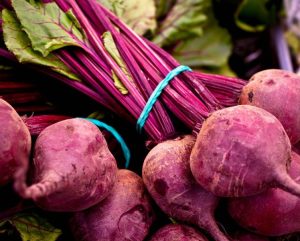
Beet, Red – Red beets are root vegetables known for their earthy flavor and vibrant red-purple color. They are rich in nutrients like folate, manganese, potassium, dietary fiber, and antioxidants such as betalains, which help reduce inflammation and support heart health. Both the roots and greens are edible, with the greens offering additional nutrients like vitamins A and C. Beets can be eaten raw in salads, roasted, boiled, or blended into smoothies and soups. Store beet greens separately from the root, wrapped in a damp cloth or in a plastic bag in the fridge. Use within a few days – they don’t keep long. Beetroots can be stored in a plastic bag in the fridge’s crisper drawer for up to two weeks. To freeze beets for longer storage, slice or chop them, spread on a cookie sheet to flash freeze, then transfer to freezer bags where they can be stored for up to a year.
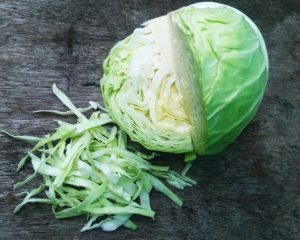 Cabbage, Green – Green cabbage is a nutrient-dense cruciferous vegetable in the Brassica family, known for its tightly packed, round, pale green leaves. It is rich in vitamins C and K, as well as fiber and antioxidants, which are beneficial for immune health, digestion, and bone strength. With a mild, slightly peppery taste, green cabbage can be enjoyed raw in salads and slaws, or cooked in stir-fries, soups, and stews. To store, keep green cabbage unwashed in a perforated plastic bag in the refrigerator’s crisper drawer, where it can stay fresh for up to two weeks.
Cabbage, Green – Green cabbage is a nutrient-dense cruciferous vegetable in the Brassica family, known for its tightly packed, round, pale green leaves. It is rich in vitamins C and K, as well as fiber and antioxidants, which are beneficial for immune health, digestion, and bone strength. With a mild, slightly peppery taste, green cabbage can be enjoyed raw in salads and slaws, or cooked in stir-fries, soups, and stews. To store, keep green cabbage unwashed in a perforated plastic bag in the refrigerator’s crisper drawer, where it can stay fresh for up to two weeks.
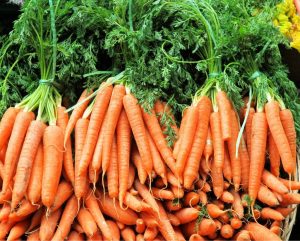 Carrot – Carrots are a versatile and popular root vegetable, known for their sweet, crunchy texture and vibrant orange color, though they can also be found in purple, yellow, and red varieties. They are rich in beta-carotene, which the body converts to vitamin A, essential for good vision and immune health. Carrots are a good source of dietary fiber, potassium, and antioxidants. Enjoy them raw, cooked, roasted, or juiced. They can be used in salads, soups, stews, and side dishes. For optimal storage, store carrots unwashed in the fridge, preferably in a plastic bag or container to maintain moisture, where they can last for several weeks. If the greens are attached, cut them off to prevent the carrots from becoming limp. Stored properly, they should last around 1-2 weeks.
Carrot – Carrots are a versatile and popular root vegetable, known for their sweet, crunchy texture and vibrant orange color, though they can also be found in purple, yellow, and red varieties. They are rich in beta-carotene, which the body converts to vitamin A, essential for good vision and immune health. Carrots are a good source of dietary fiber, potassium, and antioxidants. Enjoy them raw, cooked, roasted, or juiced. They can be used in salads, soups, stews, and side dishes. For optimal storage, store carrots unwashed in the fridge, preferably in a plastic bag or container to maintain moisture, where they can last for several weeks. If the greens are attached, cut them off to prevent the carrots from becoming limp. Stored properly, they should last around 1-2 weeks.

Carrot, Rainbow – In addition to the nutritional benefits above, rainbow carrots stand out from standard orange carrots with their vibrant colors—purple, yellow, red, and white—each offering unique nutritional benefits and distinct flavors. Purple carrots contain anthocyanins, powerful antioxidants linked to anti-inflammatory and heart-health benefits, with a slightly earthy, spicy taste. Yellow carrots are rich in lutein, which promotes eye health by protecting against macular degeneration and cataracts, and they have a mild, subtly sweet flavor. Red carrots contain lycopene, a potent antioxidant that supports heart health, reduces the risk of certain cancers, and helps protect skin from UV damage, with a richer, sweeter taste.
These colorful carrots are perfect for adding visual appeal to dishes and enhancing the taste profile, whether roasted to bring out their natural sweetness, or sliced raw for salads. Their distinct flavors can also add depth to juices and smoothies. The diverse hues, flavors, and nutrients of rainbow carrots make them perfect for garnishes or serving as part of a vegetable medley. Store rainbow carrots the same way you would store standard orange carrots.
 Greens, Asian – Asian greens are a diverse group of leafy vegetables, including varieties like bok choy, gai lan, mizuna, and tatsoi, known for their tender leaves and mild, slightly peppery flavors. They are rich in vitamins A, C, and K, as well as antioxidants and fiber, making them a nutritious addition to meals. These greens are versatile and can be enjoyed raw in salads, stir-fried, steamed, or added to soups and noodle dishes. Store Asian greens in the refrigerator, ideally in a plastic bag or container with a damp paper towel to maintain freshness, and use them within a week for the best quality.
Greens, Asian – Asian greens are a diverse group of leafy vegetables, including varieties like bok choy, gai lan, mizuna, and tatsoi, known for their tender leaves and mild, slightly peppery flavors. They are rich in vitamins A, C, and K, as well as antioxidants and fiber, making them a nutritious addition to meals. These greens are versatile and can be enjoyed raw in salads, stir-fried, steamed, or added to soups and noodle dishes. Store Asian greens in the refrigerator, ideally in a plastic bag or container with a damp paper towel to maintain freshness, and use them within a week for the best quality.
 Jerusalem Artichoke – Jerusalem artichokes, or sunchokes, are nutty, slightly sweet tubers loaded with iron, potassium, and inulin, a fiber that supports digestion. They can be roasted, added to soups or stews, eaten raw in salads, or mashed as a potato substitute. Store them unwashed in a cool, dark place or in a paper bag in the fridge, where they can last up to 2–3 weeks.
Jerusalem Artichoke – Jerusalem artichokes, or sunchokes, are nutty, slightly sweet tubers loaded with iron, potassium, and inulin, a fiber that supports digestion. They can be roasted, added to soups or stews, eaten raw in salads, or mashed as a potato substitute. Store them unwashed in a cool, dark place or in a paper bag in the fridge, where they can last up to 2–3 weeks.
Fun Facts: Despite the name, Jerusalem artichokes are not related to artichokes—they’re actually a type of sunflower root! They are also known as sunchokes. They’re sometimes called earth apples or sunroot because they’re the edible tubers of a type of sunflower.

Lettuce, Loose Leaf – Leaf lettuce, known for its loose, leafy structure and mild, slightly sweet flavor, comes in green and red varieties. It is a low-calorie vegetable packed with vitamins A, C, and K, as well as folate and fiber, making it a nutritious choice for salads and wraps. Its tender leaves are best used raw in salads, sandwiches, or as a garnish. Store leaf lettuce in the refrigerator, loosely wrapped in a damp paper towel inside a plastic bag or container, and use it within a week to maintain freshness and crispness.
Mushroom Varieties
Store mushrooms in a paper bag or breathable container in the refrigerator, avoiding moisture buildup, and only wash them right before use to maintain freshness.
Mushrooms are super versatile in the kitchen. Here are 10 Things You Should Do With Mushrooms.
This roundup of 20 Mushroom Recipes has you covered with meal ideas for breakfast, lunch, or dinner.
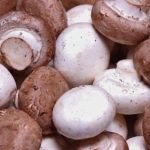
Mushroom, Portobello & Cremini – Portobello mushrooms are mature versions of cremini mushrooms, offering a meaty texture and rich, earthy flavor. Cremini, also known as “baby bellas,” are younger, smaller, and have a firmer texture with a milder taste. Both are low in calories, fat-free, cholesterol-free, and provide B vitamins, selenium, potassium, and antioxidants. Portobellos are ideal for grilling, roasting, or as a meat substitute in burgers, sandwiches, or stuffed recipes. Creminis are great for sautéing, adding to soups, stir-fries, pasta dishes, or as pizza and salad toppings.
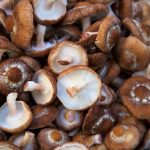 Mushroom, Shiitake – Shiitake mushrooms are prized for their rich, umami flavor and slightly chewy texture, making them a staple in Asian cuisine. They are low in calories, fat-free, and a good source of B vitamins, copper, selenium, and immune-supporting polysaccharides. Shiitakes are versatile and can be sautéed, stir-fried, grilled, or added to soups, stews, and sauces for a depth of flavor. They are popular in dishes like ramen, risotto, and dumplings, and are often used in vegetarian recipes for their meaty texture.
Mushroom, Shiitake – Shiitake mushrooms are prized for their rich, umami flavor and slightly chewy texture, making them a staple in Asian cuisine. They are low in calories, fat-free, and a good source of B vitamins, copper, selenium, and immune-supporting polysaccharides. Shiitakes are versatile and can be sautéed, stir-fried, grilled, or added to soups, stews, and sauces for a depth of flavor. They are popular in dishes like ramen, risotto, and dumplings, and are often used in vegetarian recipes for their meaty texture.
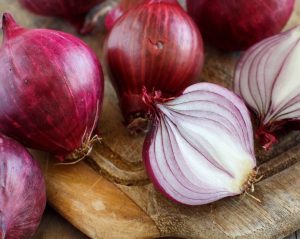 Onion, Red – Red onions are a vibrant, mildly sweet onion variety with a sharp bite, commonly used raw or cooked in various dishes. They are a good source of vitamin C, antioxidants, and fiber, contributing to overall health and supporting the immune system. Red onions add color and flavor to salads, salsas, sandwiches, pickles, and roasted vegetable dishes. Store whole red onions in a cool, dry, well-ventilated space away from sunlight; once cut, refrigerate in an airtight container and use within a few days to preserve freshness.
Onion, Red – Red onions are a vibrant, mildly sweet onion variety with a sharp bite, commonly used raw or cooked in various dishes. They are a good source of vitamin C, antioxidants, and fiber, contributing to overall health and supporting the immune system. Red onions add color and flavor to salads, salsas, sandwiches, pickles, and roasted vegetable dishes. Store whole red onions in a cool, dry, well-ventilated space away from sunlight; once cut, refrigerate in an airtight container and use within a few days to preserve freshness.
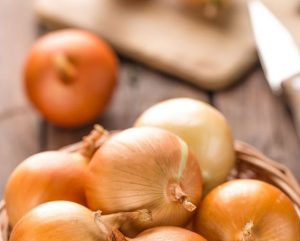
Onion, Yellow – Yellow onions are a popular, versatile vegetable with golden-brown skin and a strong, savory flavor that mellows and sweetens when cooked. Rich in antioxidants, vitamin C, and fiber, yellow onions support immune health, digestion, and overall cellular health. They’re a staple in many cuisines, perfect for sautéing, caramelizing, roasting, and adding depth to soups, stews, and sauces. To store, keep unpeeled yellow onions in a cool, dry, well-ventilated place, away from potatoes, where they can last up to a month; once peeled or cut, store them in an airtight container in the refrigerator for up to a week.
 Parsnip – Parsnips are root vegetables with pale, creamy skin and a sweet, nutty flavor, especially when cooked. They are high in fiber, vitamin C, and folate, which promote digestion, immune health, and cell function. Parsnips are great roasted, mashed, added to soups, or used as a potato substitute. Parsnips can be spiralized into veggie noodles or blended into creamy soups for a subtly sweet, earthy flavor. Their natural sweetness also makes them a great addition to baked goods like muffins or cakes. Store unwashed parsnips in the refrigerator crisper drawer, where they can last for two to three weeks.
Parsnip – Parsnips are root vegetables with pale, creamy skin and a sweet, nutty flavor, especially when cooked. They are high in fiber, vitamin C, and folate, which promote digestion, immune health, and cell function. Parsnips are great roasted, mashed, added to soups, or used as a potato substitute. Parsnips can be spiralized into veggie noodles or blended into creamy soups for a subtly sweet, earthy flavor. Their natural sweetness also makes them a great addition to baked goods like muffins or cakes. Store unwashed parsnips in the refrigerator crisper drawer, where they can last for two to three weeks.
Tip: Add parsnips to baked goods like muffins or cakes for a mild sweetness and extra moisture, similar to how carrots are used in carrot cake. Parsnips tend to be sweeter during winter, as the cold converts their starches into natural sugars.
 Potato, Red – Red potatoes are small to medium-sized with smooth red skin and a creamy texture. They are rich in potassium, vitamin C, and fiber, supporting heart health, immune function, and digestion. Their waxy texture makes them perfect for roasting, boiling, or using in potato salads. Red potatoes are also great for grilling on skewers or smashing and crisping in the oven for a simple yet flavorful side dish. Their thin, tender skin doesn’t need peeling, adding color and nutrients to dishes. Store them in a cool, dark, well-ventilated place, away from sunlight, for several weeks.
Potato, Red – Red potatoes are small to medium-sized with smooth red skin and a creamy texture. They are rich in potassium, vitamin C, and fiber, supporting heart health, immune function, and digestion. Their waxy texture makes them perfect for roasting, boiling, or using in potato salads. Red potatoes are also great for grilling on skewers or smashing and crisping in the oven for a simple yet flavorful side dish. Their thin, tender skin doesn’t need peeling, adding color and nutrients to dishes. Store them in a cool, dark, well-ventilated place, away from sunlight, for several weeks.
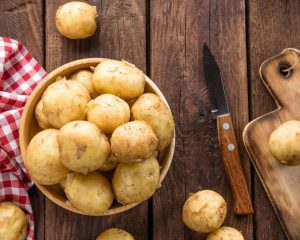 Potato, Yellow – Also known as Yukon Gold or gold potatoes, yellow potatoes have smooth, thin, yellowish skin and creamy, buttery-flavored flesh. They are slightly waxy, making them versatile in cooking. Yellow potatoes are a good source of vitamin C, potassium, and fiber and are low in calories and fat. Their creamy texture makes them ideal for mashing, roasting, grilling, and boiling. They are also excellent in gratins and salads because they hold shape during cooking. Store yellow potatoes in a cool, dark, and well-ventilated place for several weeks, avoiding refrigeration as it can alter their texture and flavor.
Potato, Yellow – Also known as Yukon Gold or gold potatoes, yellow potatoes have smooth, thin, yellowish skin and creamy, buttery-flavored flesh. They are slightly waxy, making them versatile in cooking. Yellow potatoes are a good source of vitamin C, potassium, and fiber and are low in calories and fat. Their creamy texture makes them ideal for mashing, roasting, grilling, and boiling. They are also excellent in gratins and salads because they hold shape during cooking. Store yellow potatoes in a cool, dark, and well-ventilated place for several weeks, avoiding refrigeration as it can alter their texture and flavor.
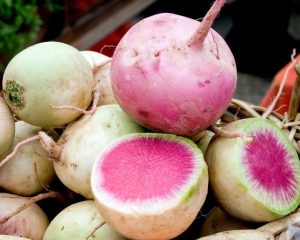 Radish, Watermelon – Watermelon radish is a striking root vegetable with a mild, slightly sweet flavor and a crisp texture. Its pale green skin hides a vibrant pink interior, resembling a watermelon. Rich in vitamin C, potassium, and antioxidants, it supports immune health and reduces inflammation. Watermelon radishes can be enjoyed raw in salads, sliced thinly for garnishes, pickled, or roasted for a milder flavor. Store unwashed watermelon radishes in a perforated plastic bag in the refrigerator, where they can stay fresh for up to two weeks. Wash and trim just before using.
Radish, Watermelon – Watermelon radish is a striking root vegetable with a mild, slightly sweet flavor and a crisp texture. Its pale green skin hides a vibrant pink interior, resembling a watermelon. Rich in vitamin C, potassium, and antioxidants, it supports immune health and reduces inflammation. Watermelon radishes can be enjoyed raw in salads, sliced thinly for garnishes, pickled, or roasted for a milder flavor. Store unwashed watermelon radishes in a perforated plastic bag in the refrigerator, where they can stay fresh for up to two weeks. Wash and trim just before using.
 Rutabaga – Rutabaga is a round, root vegetable with yellowish flesh and a mildly sweet, earthy flavor. It is packed with fiber, vitamin C, and potassium, supporting digestion, immune health, and heart function. Rutabaga is excellent roasted, mashed, added to soups, or used in stews. Rutabaga can be thinly sliced and baked into crispy chips or grated and mixed into coleslaw for a unique twist. Its slightly sweet flavor also works wonderfully in casseroles or mixed with mashed potatoes for added depth. Store rutabaga in a cool, dark place or in the refrigerator, where it can stay fresh for several weeks.
Rutabaga – Rutabaga is a round, root vegetable with yellowish flesh and a mildly sweet, earthy flavor. It is packed with fiber, vitamin C, and potassium, supporting digestion, immune health, and heart function. Rutabaga is excellent roasted, mashed, added to soups, or used in stews. Rutabaga can be thinly sliced and baked into crispy chips or grated and mixed into coleslaw for a unique twist. Its slightly sweet flavor also works wonderfully in casseroles or mixed with mashed potatoes for added depth. Store rutabaga in a cool, dark place or in the refrigerator, where it can stay fresh for several weeks.
Fun Facts: Rutabagas are a cross between a turnip and a cabbage, giving them their unique flavor. Rutabaga is also known as swede which is short for “Swedish turnip.”
 Sweet Potato – Sweet potatoes are a nutritious root vegetable known for their naturally sweet flavor and vibrant orange flesh, though they also come in other colors like purple and white. They are rich in vitamins A (as beta-carotene), C, and B6, as well as dietary fiber, potassium, and antioxidants. These nutrients support eye health, boost immunity, and promote digestive health. Sweet potatoes are versatile in cooking and can be baked, roasted, mashed, or used in soups and stews. They can also be enjoyed in both savory and sweet dishes. Store sweet potatoes in a cool, dark, well-ventilated place for several weeks, avoiding refrigeration as it can affect their texture and flavor.
Sweet Potato – Sweet potatoes are a nutritious root vegetable known for their naturally sweet flavor and vibrant orange flesh, though they also come in other colors like purple and white. They are rich in vitamins A (as beta-carotene), C, and B6, as well as dietary fiber, potassium, and antioxidants. These nutrients support eye health, boost immunity, and promote digestive health. Sweet potatoes are versatile in cooking and can be baked, roasted, mashed, or used in soups and stews. They can also be enjoyed in both savory and sweet dishes. Store sweet potatoes in a cool, dark, well-ventilated place for several weeks, avoiding refrigeration as it can affect their texture and flavor.
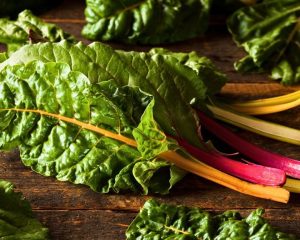 Swiss Chard – Swiss chard is a vibrant leafy green vegetable, rich in vitamins A, C, and K, as well as magnesium, potassium, and iron, making it a nutritious, low-calorie option. The stems come in various colors or simply a whitish green. Both the leaves and the stalks are edible. When picked very young, chard can be part of a green salad. But full-grown chard like in your box today has a very strong flavor and tough stems when eaten raw. Its slightly bitter, earthy flavor pairs well with garlic, lemon, and olive oil, and it can be sautéed or steamed. After cooking for several minutes, it can also be added to rice and beans or omelets. Chard can be sliced or chopped and added to soups. The stems work well in soups, stews, or as a celery substitute. Use Chard any way you would prepare spinach, allowing for longer cooking time for the stems. To store, keep unwashed in a plastic bag or container in the refrigerator’s crisper drawer, using it within 3–5 days; if it wilts, revive it by soaking in cold water before use. Before using, wash well in cool water and separate the leaves from the stems.
Swiss Chard – Swiss chard is a vibrant leafy green vegetable, rich in vitamins A, C, and K, as well as magnesium, potassium, and iron, making it a nutritious, low-calorie option. The stems come in various colors or simply a whitish green. Both the leaves and the stalks are edible. When picked very young, chard can be part of a green salad. But full-grown chard like in your box today has a very strong flavor and tough stems when eaten raw. Its slightly bitter, earthy flavor pairs well with garlic, lemon, and olive oil, and it can be sautéed or steamed. After cooking for several minutes, it can also be added to rice and beans or omelets. Chard can be sliced or chopped and added to soups. The stems work well in soups, stews, or as a celery substitute. Use Chard any way you would prepare spinach, allowing for longer cooking time for the stems. To store, keep unwashed in a plastic bag or container in the refrigerator’s crisper drawer, using it within 3–5 days; if it wilts, revive it by soaking in cold water before use. Before using, wash well in cool water and separate the leaves from the stems.
Fun fact: Chard is in the chenopod family which includes beets, spinach, and quinoa.
Don’t Forget: Online shopping opens Friday at 3 PM! 🛒 Stock your kitchen with these clean, nourishing ingredients to fuel your family with nutrient-dense meals. Be sure to grab your favorite staples and try something new for vibrant health this winter.
Don’t wait to join…
Veggie E-Books
Download these collections of tips and recipes for each veggie. You’ll use these as a reference throughout the season.
Beets E-Book
Cabbage E-Book
Carrots E-Book
Mushrooms E-Book
Onions E-Book
Potatoes E-Book
Radish E-Book
Farm News and Events
🍞 Next Sourdough Bread Baking Workshop – Sign Up!
Get ready for a fun, hands-on experience in the art of sourdough bread making!
Join us on Saturday, March 29, 2025, for our Sourdough Bread Baking Workshop at Willow Haven Farm.
Whether you’re a beginner or a seasoned baker, this workshop will give you the skills and confidence to bake delicious, homemade sourdough bread from scratch.

👩🍳 What to Expect on March 29th:
- Step-by-step guidance from our expert instructor
- Hands-on experience making your own sourdough starter
- Tips for perfecting your bread at home
- A chance to meet other bread enthusiasts in a fun, relaxed environment
✨ Don’t miss out on this opportunity to take your baking to the next level!
We’ll keep farming for you!
Reuben and Tessa DeMaster
Willow Haven Farm


